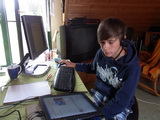 Some examples of our work
Some examples of our work

|
TOIS - phases of work, diagnostics and therapy
The therapeutic part is divided into four steps.
1. The Diagnosis
…detects and specifies psychological causes for the client`s behavior at school. The system diagnostics involve all previous educational institutions and relevant reference persons. Classical methods of performance diagnostics are applied as well.
The diagnostic phase
As far as possible, the diagnosis phase takes place face–to–face. The client also becomes familiar with all the necessary technical and methodological procedures of the work to come.
2. Therapy
The four parts of the therapeutic work
Step 1: Isolation of fear-induced areas and channel
After the diagnosis we have a verification of the client’s psychological disorder and his or her performance.
The client can now communicate with the TOIS teachers and the psychologist anonymously via the net. The fear-induced areas, known on the basis of the diagnosis, remain untouched, such as the presence of an adult, the necessity to answer questions timely, the feeling of being seen by a teacher, public speaking, the change of perspective, his or her own wording, certain topical areas, etc. The topic and level of a subject matter solely depend on the aim to provoke a positive experience of self-esteem for the client and to build self-confidence and trust in the therapist. In order to reach this aim the therapist is guided by the client without giving up his role.
Step 2: Exposure
 When the client feels safe enough, the TOIS teachers and the psychologist guide him or her through fear-induced areas. Also here, the subject matter is part of the work without giving importance to the learning results. At the beginning, the client verbalizes what he or she thinks is going to happen and then compares the result with the assumption. The TOIS teacher / psychologist guides the client so that he or she realizes the contradictions in the assumption. At the same time, the demands are raised step by step in order to reach a rhythm similar to school. When the client feels safe enough, the TOIS teachers and the psychologist guide him or her through fear-induced areas. Also here, the subject matter is part of the work without giving importance to the learning results. At the beginning, the client verbalizes what he or she thinks is going to happen and then compares the result with the assumption. The TOIS teacher / psychologist guides the client so that he or she realizes the contradictions in the assumption. At the same time, the demands are raised step by step in order to reach a rhythm similar to school.
This step is similar to a conventional anxiety treatment but is based on the “back and forth” of the therapist’s presence due to the communication via the internet.
Step 3: Stabilization and synchronization
The achieved status needs training.
Methodologically, TOIS becomes similar to school (motivational phase, sub objectives, objective and more face–to–face lessons, e-learning for self-directed learning, grades, homework). Very often, a cooperation agreement with the future regular school is concluded. In the main subjects the matter is taught exactly like at school (German, math, English, physics, biology, geography, history).
Step 4: Check of the results in practice – regular school enrollment
The coaching of the school is the most important aspect of this step. Part of this is to inform the school about the client’s disorder or difficulties. Also, the teachers and the competent LIZ psychologist meet on a regular basis. The fourth step concludes with the client leaving the TOIS program.
|